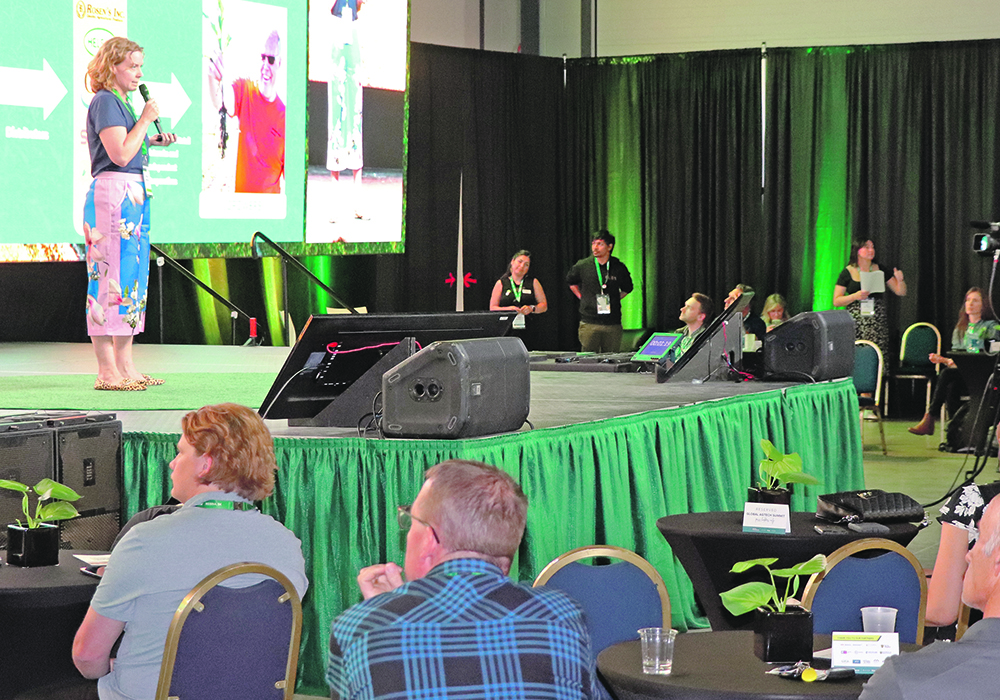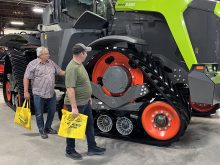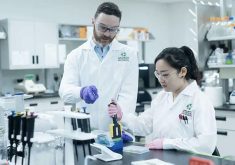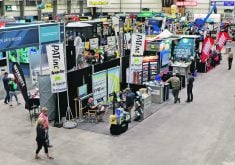Sixteen companies pitch new products to woo potential investors at Canada’s Farm Show in Regina last month
Regina — Canada’s Farm Show is shifting away from vast parking lots full of large farm equipment displays toward the fast-moving and lucrative agtech space.
The highlight of the three-day show, which was held in Regina June 20-22 this year, was the Launch Pad stage that hosted product launches and panel discussions on topics that included agtech investing, producer perspectives on agtech and how technology is accelerating agriculture.
The two most-attended events were the 24-hour Start Up Agtech pitch finale, and the Agtech Accelerator that had leaders from 16 new companies pitch their products.
The Agtech Accelerator was established by Economic Development Regina and Emmertech, a $60 million Conexus Venture Capital fund that focuses on agtech and agribusiness innovation.
To qualify for the program, companies had to be venture-capital-backed, with a minimum $100,000 of equity investment.
Once selected for the three-month program, the agtech companies have the opportunity to receive an equity investment from Emmertech, as well as programming, connections and mentorship to help them scale up.
This is the second year for the Agtech Accelerator.
During Canada’s Farm Show, each company had a few minutes to pitch their products to potential investors.
The 2023 Agtech Accelerator cohort:
AgriSound uses sensors to automate pollinator monitoring and creates data to help farmers make better-informed decisions.
Casey Woodward, founder and chief executive officer of AgriSound, said 75 percent of all food systems rely on pollinators.

“However, insects are going through a pretty tough time at the moment. We’re finding that insects are dying out the whole range of different reasons,” Woodward said during his pitch.
“What we set up at AgriSound, is the ways that we can use this information to deliver precision inputs to protect pollinator communities and protect food security at the same time.”
He said there are not enough ecologists and they don’t have the budgets to lead the recovery efforts for many pollinators.
AgriSound uses an in-field sensor called Polly for automated insect monitoring that uses advanced bioacoustics algorithms, which enables direct mapping of pollinator activity in-field to target areas of low pollinator counts for remedial action or managed bee populations.
Arthur Chen, co-founder of Verdi, said the infrastructure for delivering water and fertilizer on irrigated farms is outdated and inefficient.

“It uses miles of plastic tubing to just dump water and fertilizer on crops causing farmers to waste up to 60 percent of their inputs, but most importantly it’s up to 10 percent of the crop production,” Chen said.
He said this is why Verdi offers plant-level healthcare to customize water and fertilizer at the plant level.
“Our software uses satellite imagery to create prescriptions for farmers. We then retrofit farm infrastructure with fleets of smart devices to control tiny valves for targeted water and fertilizer delivery.”
The hardware Verdi deploys comes with proprietary algorithms for automation networking and battery management.
Once the hardware is connected online, the company can control it with AI to help growers manage their crops.
OneCup AI uses its AI program called BETSY (bovine expert tracking and surveillance) to help farmers manage their herds.

Mokah Shmigelsky, CEO of OneCup AI, said BETSY seamlessly identifies, tracks and monitors livestock.
“She (BETSY) uses advanced computer vision technology to uniquely identify your animals and track their changes in behaviour, activity and health, providing you with seamless data to manage your herd,” Shmigelsky said.
Information on the herd is automatically collected and available on an online platform.
“We have a proactive alert system to enable producers to know what is going on with their animals at any given moment,” Shmigelsky said.
“With our custom video player, the producer can view their animals through the BETSY lens. You can quickly identify animal cards and individual animals within the video player itself and easily pull up notifications that you might have missed.”
Xavier Hébert-Couturier, CEO of Picketa Systems, said the company is developing a real-time plant tissue analysis for agronomists and farmers that will tell them what a crop needs, when they need to know it.

Picketa Systems is taking on the problem of the delay between when a tissue sample is taken to when the results are available, with its tissue sampler called LENS.
“You go take your sample, scan 10 to 15 leaves, then with our platform online you can see what parts of your field have which concentrations, and then act accordingly. You can see which fields need your attention the most and you can act that same day.”
So far, LENS supports potato production, but it will be expanded to other crops.
“So, the value prop here is of course saving time on sampling, comparing field trials closely, being able to diagnose issues right when you can fix them and automated reporting,” Hébert-Couturier said.
“You can send reports within a couple minutes instead of having to do a lot of data analysis. The agronomists can quickly coordinate a plan of action with their growers once you get your results. The goal here is to maximize fertilizer application and your yield at the end of the season.”
Tom Devine, lead AI engineer at AgriSynth, said the company specializes in building complex, synthetic imagery for training AI.

“We are on a mission to become the go-to solution for computer vision in agriculture,” Devine said.
To train a computer vision system, many images are necessary and they must be labelled to train the AI model.
When the model does not recognize something, it has to be further trained, which is timely and costly.
In agriculture, there are also many variables that must be considered when training a computer vision program, including different soil types.
“We can produce millions of images very quickly and automatically train AI solutions for you,” Devine said.
“We have computer vision experts for agriculture. We can be your trusted partners to help you deliver what you need to deliver without having to waste your time when we can do it for you.”
CultivateCI offers a proprietary carbon scoring system and predictive analytics tools that help connect buyers of carbon credits to farmers that sequester carbon.

Boyd Koldingnes, CEO of CultivateCI, said there has been no standardized approach to measuring, reporting and validating carbon offsets, until now.
“Our platform is focused around the monitoring, the reporting and the verification (of carbon sequestration). So we use on-farm data, we do have the patent pending to use multi-source on farm data in real time. And so that’s the first of its kind in the carbon industry,” Koldingnes said.
“We measure the carbon intensity, which is the amount of carbon produced per ton of crop grown.”
He said competitors typically use model data, not actual on-farm data as CultivateCI does, which gives the company a unique position in the industry.
Producers will start to see low carbon grain programs offered by large grain companies, which can provide growers a substantial revenue stream if they measure how their existing practices affect carbon sequestration, Koldingnes said.
“For grain buyers, it opens up the market for low-carbon premium grain, which we’re already starting to see in Europe and around the world and for cpg (consumer packaged goods) companies like Walmarts. It’s fully traceable, low-carbon products that you can actually back and verify,” he said.
Megan Wheeler, chief of staff of Vive Crop Protection, said the company is creating better pesticides, biological and synthetic-based.

“We’re fully commercialized and our products were put on over two million acres last year,” Wheeler said.
“We have an innovative and patented nanopolymer technology that can be mixed with pesticides for application in the jug, in the tank, in the soil, on the seed or on the leaf, and it’s very cost-effective and scalable.”
Nanopolymers, unlike most composites, cannot dissociate in solutions. Vive’s polymer products are designed for optimal compatibility and performance, ensuring each active ingredient performs well.
Vive’s products mix well with no clogging of nozzles, lines or screens. It helps formulas stay in suspension better, even in cold weather, and requires no additional equipment to apply.
Vive also has a product that prevents the dust-off of seed treatments, as well as a product that prolongs the shelf life of biological-based products.
Flox developed an AI-powered system that helps producers manage large chicken barns.
Imtiaz Shams, CEO of Flox, said the variability in mortality, chicken weights and temperature fluctuations in barns all need to be monitored and managed closely.

“Multiply that by the 400,000 chicken houses there in the world doing 66 billion broiler chickens, and that’s the scale of both the challenge and the opportunity,” Shams said.
“We put cameras and use various types of artificial intelligence and sensing in the sheds to figure out what the birds are doing. This includes how they’re growing. For example, we can weigh 50,000 birds in an hour at 95 percent accuracy. No one else can do that with just cameras.”
Flox also incorporates the sensing systems already installed in chicken barns to its AI-based system.
Shams said the company is moving toward the turkey, duck and egg industries, as well as companies interested in verifying the welfare for the animals they buy.
Tyler Lefley, CEO of Dark Horse Ag Ventures, said the company specializes in using data that is already produced on farms to reduce the cost of variable-rate technology.

The company already has products on the market that use farm-generated data, including automated yield targets and nutrient efficiency models.
It also uses field maps and satellite imagery for its variable-rate fungicide product.
“Dark Horse Ag Ventures is building a platform that will be the farm data analytics headquarters,” Lefley said.
“We’re able to aggregate and standardized any form of precision agriculture data.”
He said the next goal for the company is to have the data analytics react to how much soil moisture is in a field.
The company uses publicly available data from NASA and creates a moisture map with 100 metres resolution.
“In the future, we’re going to bring this down to four metres. That’s what our special sauce is. In the future, we want to have a whole entire live data layer for Western Canada with soil moisture under 10-meter resolution,” Lefley said.
The platform under development, which marries nutrient-use efficiency with water modeling, is called Symbiosis.
It will be used for jobs, including the creation of split nitrogen application maps based on moisture, and to compare the performance of fertilizer products with crop-available water.
Swarm Farm Robotics builds swarms of small, nimble and autonomous platforms that can be outfitted with multiple implements.
Andrew Bate, co-founder of Swarm Farm Robotics, said there are three categories in the ag robotics market.

The first category is what he called the driverless tractors or strap-on aftermarket kits.
“We’re not really creating much new value other than getting a driver out of the cab. But this is where we see incumbents playing. It’s a big market and they’re going to fight to keep it,” Bate said.
He called the next category speciality robotics, where companies are solving deep problems in agriculture like how to robotically harvest crops, how to kill weeds without chemical and how to prune vines.
“What’s important here is these companies are creating new value that driverless tractors can’t actually get,” Bate said.
The third category, where Swarm Farm fits, is called integrated autonomy.
“What we’ve got here are specialist tool carriers designed to carry the smart technology in category two to market, as integrated attachments on board. This is critical because the high value attachments out of category two need a pathway to market so they can be adopted across wide swaths of agriculture,” Bate said.
He said his company can’t build everything so it focuses on what it calls swarm connect, which he described as the app store for autonomous agriculture.
“All of the guys developing that really high-end technology in category two can integrate their technology, be released as apps aboard our robots,” Bate said.
“We don’t need dozens, we don’t need hundreds, we literally need thousands of companies around the world developing new solutions for agriculture.”
He said Swarm Farm Robotics has 58 autonomous robots delivered to farmers that have farmed around 1.5 million acres in Australia.
SugaROx produces biostimulants to help farmers optimize productivity and improve the resilience of crop systems amid adverse weather such as drought.

Bianca Forte, business development director for SugaROx, said the technology is based on 20 years of science by Rothamsted Research and Oxford University.
“Our biostimulants will be based on a single molecule inspired by a natural blood sugar. That molecule is called trehalose-6-phosphate, but we call it T6P. T6P plays a key role in carbon use allocation by plants, and influences crop development, growth and grain filling,” Forte said.
“In its natural form, T6P cannot cross cell membranes. So, we synthesize a special version of it with a small chemical modification that allows for plant uptake following a foliar application.”
She said SugaROx biostimulants can deliver up to 20 percent yield increase in wheat, while the biostimulants on the market today deliver two to five percent yield gains.
“The natural molecule that inspired this technology is found in all plants and we’ve been testing the potential of this technology on additional crops,” Forte said.
“Our data from glasshouse trials on sorghum, millet, barley and maize is equally exciting.”
Bionema creates natural biopesticides, biostimulants and biofertilizers for agritech and public health.

Its founder and CEO, Minshad Ansari, said the company designs fungi-based pesticides to help farmers control pests, weeds and increase their productivity.
“With indiscriminate use of farm pesticides, the problem (crop losses due to pests) is increasing. The pesticides are making resistance, and their activity is decreasing,” Ansari said.
“Some of the removal of pesticides in different part of the world is creating problems as well. The European Union is brutal, in that they are going to cut 50 percent of chemical pesticide use by 2030. I think that’s going to be catastrophic within the next 10 years.”
However, crop protection can be done naturally, he said.
Bionema has collected a library of more than a thousand micro-organisms for potential use in its products. It has also developed a formulation and delivery technology that enables its products to deliver higher virulence, greater stability, better spore yields, and wider host ranges.
“We are providing a solution, a ground-breaking microencapsulation technology for the first time in the world, which can encapsulate these micro-organisms and deliver where they are needed safely and effectively,” Ansari said.
He said Syngenta has recognized Bionema’s technology and acquired two of its products in 2021
BarrelWise Technologies developed its FS1 system for managing the free sulfur dioxide in wine barrels for wineries.

Jason Sparrow of BarrelWise Technologies said the FS1 allows a single worker to access the barrels, measure free sulfur dioxide and act on the results.
He said some wineries have tens of thousands of barrels that are actively managed.
“Every two to six weeks barrels are brought down from the stands. They’re opened and samples are drawn from them. These are sent to a lab and then a little bit of sulfur is added into each barrel and put away. It’s a very labour-intensive process. But the problem is that winemakers don’t have the time or the tools to examine every barrel. This is largely because lab-throughputs are slow and what happens is unnoticed quality degradation,” Sparrow said.
“We designed our FS1 system to work directly in the cellars, take samples right from barrels and it’s 15 times faster than the industry standard wet chemistry methods. It’s very accurate. They’re reliable and it’s fully automated so anyone can use it. You don’t need to be a trained lab technician and it fits easily into any seller,” Sparrow said.
Vivid Machines is working to increase transparency from farm to retailer in the fruit supply chain.

The company’s CEO, Jenny Lemieux, said fruit growers presently collect data on their crops to understand how best to optimize volume, maximize colour, intervene for pests and diseases and try to predict whether they’re going to achieve their yield targets.
“But with millions of trees or vines, it is humanly impossible to get an accurate understanding of what’s going on in the farm, and inaccurate yield estimates lead to massive losses across the supply chain,” Lemieux said.
“So we built an easy-to-use computer vision system that mounts onto existing farm equipment, takes images of every plant and provides accurate geolocated predictions. Our system uses multi-spectral imaging to see more than the human eye so that we can detect diseases early and distinguish tiny green fruit against green leafy backgrounds, so we can do things like count and size them.”
She said Vivid Machines provide accurate predictions immediately, so growers can intervene quickly, and that data can be forwarded months before harvest to help with cost optimization for things like packaging and cold storage.
Ground Truth Ag is developing products that reduce the uncertainty of grain sampling and grading.

Divyesh Patel, company chief operating officer, said getting a representative grain sample is a problem for farmers.
“Here you are, you’re driving a grain truck off to the elevator. It’s loaded up with your grain, you’re told it’s number one, but you don’t really know what price you’re going to get until you make that transaction at that elevator,” Patel said.
He said there’s two main reasons for this uncertainty, sampling errors and the subjectivity of the grading process.
Ground Truth Ag’s desktop grain tester uses machine vision to determine grain grades, and Patel said this product addressed the subjectivity of the grain grading process.
“It provides consistent results in a high throughput manner with a comprehensive view of all the grading factors that you’re looking at for your grain,” Patel said.
So far, the desktop unit can be used for Canadian western red spring wheat, but more crops will be added in the future.
It can detect if there is ergot, sclerotinia, fusarium, mildew, immature frost, heat stress.
“In 2025 will also have an on-combine version available, which has all of the things that the bench-top unit has. In addition, it provides continual sampling of your grain,” Patel said.
He said knowing your grade quality information has many practical applications, including blending grain to take advantage of market opportunities and to use the information in precision ag programs.
“So instead of just using yield per acre, you can add quality per acre to your precision ag decisions. You can package all of that information up in a digital format, pass it off to your buyer so both the buyer and the farmer have the same information,” Patel said.
T-Bin Ag Equipment designed a telescopic, mobile grain bin with a 10,000 bushel capacity.

Trevor Phenix, a managing partner at the company, said the system will help farms manage a shortage of labour during harvest.
“From the words of a 2,000-acre farmer at Ag in Motion (farm show) last year, ‘I can buy more semi-trucks but I can’t buy more drivers.’ This goes on to prove a point that it’s not just difficult to find people, but also the logistics of harvest become quite apparent when you start to run short on key personnel required to keep the machine running,” Phenix said.
He said the biggest pain point when it comes to the labour shortage is the logistics of keeping the combines and trucks running.
“We’ve developed a product that actually allows you to retract a grain bin down to a transport family height of less than 17 feet. This actually allows a farmer to grab it with a tractor or semi and pull it without any special permits, any pilot vehicles, any road approvals or even better yet without lighting,” Phenix said.
After the pitches were completed, the audience at Agtech Accelerator voted T-Bin as the most popular product and the company was awarded $1,000.


















